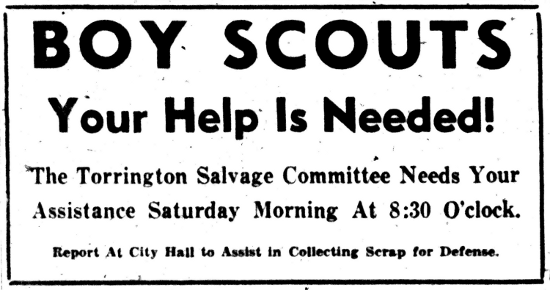War
The unforeseen strike of the Imperial Japanese Navy on the Pacific Fleet at Pearl Harbor transformed the United States from an arsenal of democracy to a full-fledged combatant. In Torrington, boys were trained as messengers, in case of communication failures during air raids. Most of the participants were Scouts, but since the Chief Air Raid Warden sought six-hundred boys over the age of fourteen, and the total membership of the Northern Litchfield County Council was only seven hundred and fifty, youth from other Boys' Clubs partook as well. In one session of the training, the boys witnessed a demonstration of incendiary bombs, and saw how fires that could not be doused with water could be extinguished. This fear of an air attack on Torrington’s war industries kept the city on edge; although Northwest Connecticut was far outside of the blackout zone, the area three miles from the New England coast where the government required citizens to dim all lights visible from the ocean, the city underwent several practice blackouts during 1942.
The fear of air raids decreased with the distance from Pearl Harbor, and Scouts focused more on resource collection than on civil defense. To supply the United States its own airplanes, the boys of the Northern Litchfield County Council, in cooperation with the Torrington-Litchfield Girl Scout Council, went door-to-door collecting aluminum. In addition to metals, the Scouts collected rags and rubber for recycling. In June of 1942, Council Executive Palmer Liddle was commissioned as a Lieutenant in the Air Division of the United States Navy. Liddle may have been pursuing a commission for some time, perhaps as early as 1941, when he recruited Clarence Rosenbeck to direct Camp Workcoeman. Before the Council Executive resigned, he hired Carl Bergquist, Assistant Director for four years, to take the helm for the summer.
For most members of the Boy Scouts of America, the main concern during the summer of 1942 was getting to camp. Scouts of the 1920s often took trolleys part of the way to their camp, but most of these lines went bankrupt during the Great Depression. In the 1940s, an automobile ride was the predominate way to go camping, but wartime restrictions complicated that journey. Gasoline rationing made the hundred mile round trip to the New Britain Area Council’s Camp Keemosahbee difficult. Even more of a challenge was the one hundred and fifty mile circuit for the boys of Stamford’s Alfred W. Dater Council. However, unlike most Scout councils, the Northern Litchfield County Council’s Camp Workcoeman was within its jurisdiction. For the population centers of Winsted and Torrington, Workcoeman was five and seven miles away, respectively. Scouts could easily carpool, and the Scout Mothers' Auxiliary revived its original mission, providing transportation to Boy Scout activities. Without gasoline, camp was a half-day hike, even for a dilatory tenderfoot. While most Scout camps had to cut back their programs during the Second World War, Workcoeman’s location allowed it to maintain attendance, and even expand.
The image below shows a notice from page nine of the Torrington Register of 29 July 1942, encouraging participation in war service.
